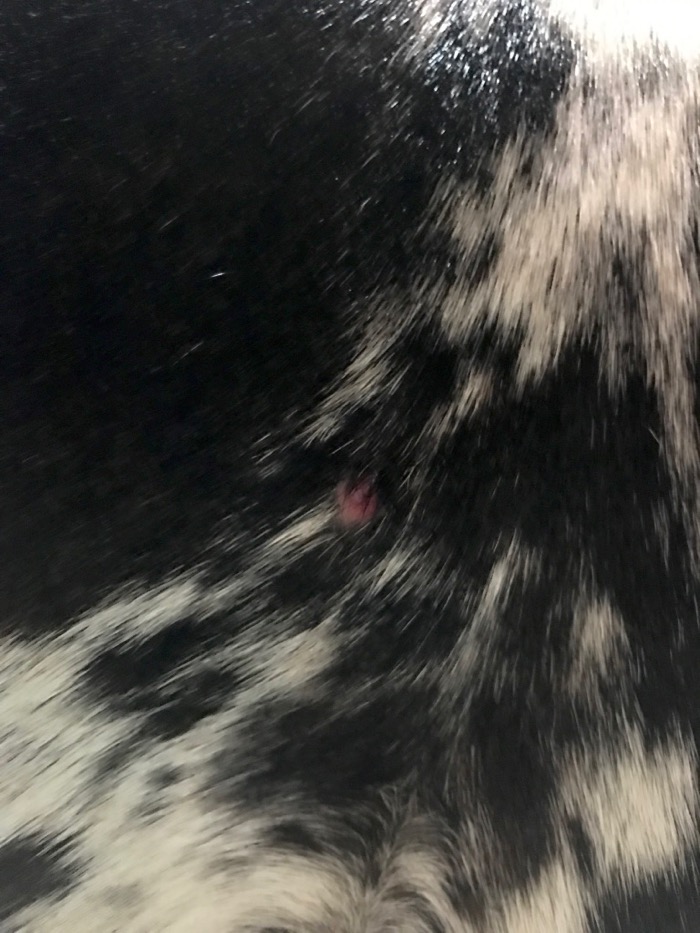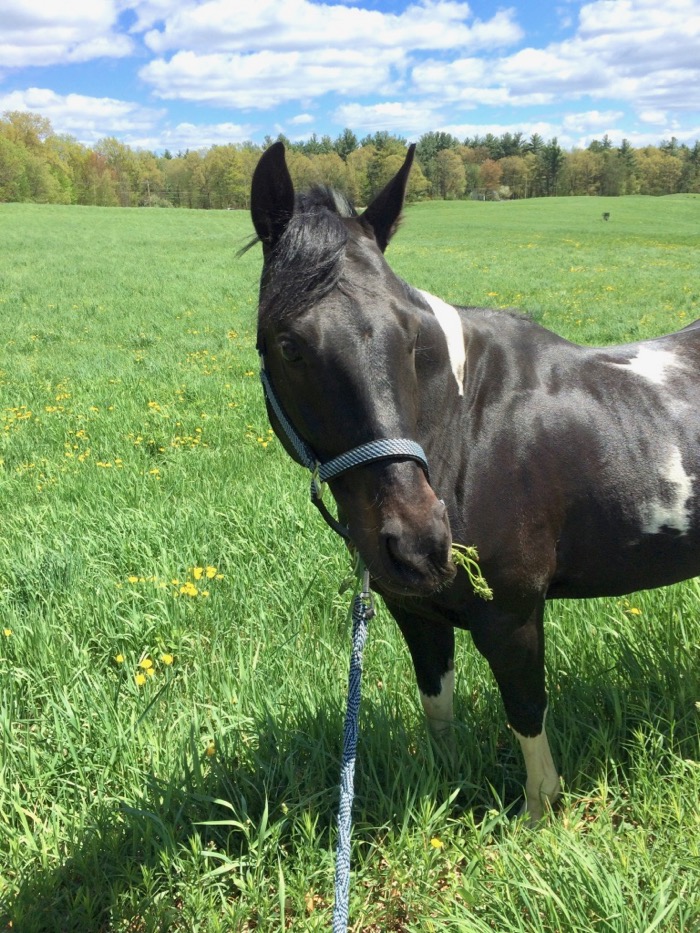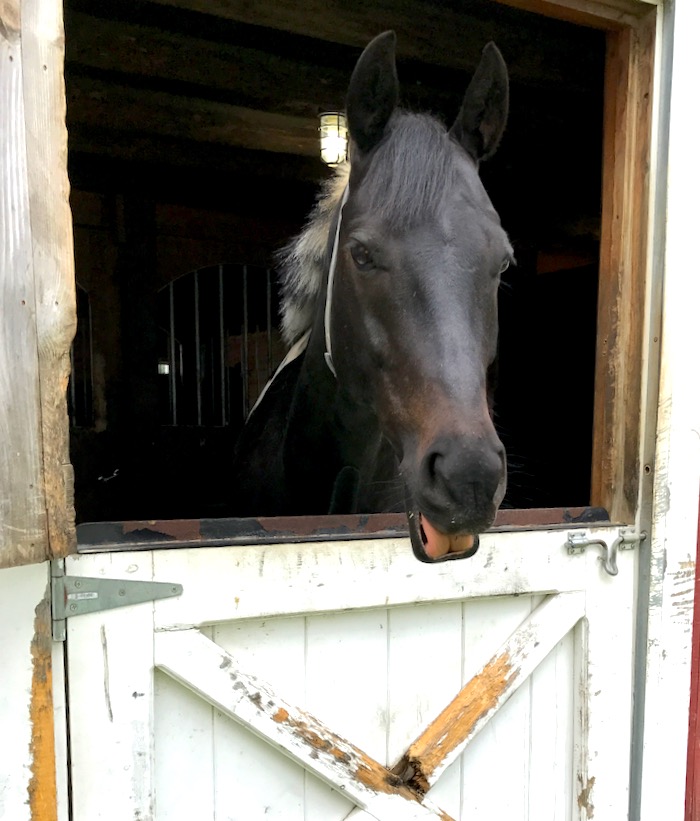UPDATE: Although Tonka wore a Soresto collar all last summer with no issues, this year, it rubbed, caused irritation and hair loss, and slight swelling. I don’t know if the collar has been reformulated, or if Tonka developed a sensitivity. Obviously, he won’t be wearing it. I know horses that are wearing dog tick collars without any negative reactions, so I still believe that this is an option for some. Let me know if you’ve had success – or failure – with this or any other method.
Although snow is predicted for later this week (yes, it’s April, someone please tell Mother Nature!), it’s tick season here in New England. With the ticks come diseases. Really, really terrible ailments. The one we all are aware of is Lyme disease. That’s named for the town of Lyme, Connecticut, which is the epicenter of this scourge. (By the way, it’s a lovely town, and I feel sorry that it’s now linked to this disease.) Lyme is only 100 miles away from my home.
I’ve known horses permanently lamed from Lyme. Or that have aches that come and go. Or they have neurological damage. There’s no vaccine. There’s only prevention. To prevent Lyme, you have to keep the ticks from attaching to your horse. The problem is that these ticks are as tiny as pin heads, and your horse is large and covered with fur. They can be there and you don’t know it.
During tick season I am especially vigilant in my grooming, and run my hands over all of Tonka’s body. He’s one of those horses that immediately reacts to a tick’s bite. He gets a tell-tale lump. Look closely and you’ll see the raised circle in the center of that bare spot. Sometimes you can see the tick, but sometimes it’s like this – there’s a tick under the skin.

It’s totally gross, but if I scratch it with my fingernail, the tick is exposed, and I use special tick tweezers to pull it out. But by the time you see this lump, the tick could have already sickened your horse. It’s best to prevent them from attaching in the first place.
I know people who stay in rings, and turn their horses out on dirt, just to avoid ticks. Not only does that not entirely work, but it’s no life for a horse.
On the other hand, as happy as Tonka is in this field, letting him hang out there probably isn’t the smartest thing to do, as high grass is a tick’s favorite place.

Tonka has white legs, which makes the ticks visible, and after a little graze like this (he got five minutes before loading into a trailer), I check him obsessively and brush him down.
Last year, I upped my attempt at protection. Before we go out on the trails, I spray exercise boots with a pyrethrin-based repellent. The ticks can’t traverse the boots to get up to his body.

When riding, I try to stay on the trail and out of the tall grass. But, since that’s not always possible, I also spray the rest of him.

Some people use a topical product to protect their horses. This can be a good option. However, these pesticides need to penetrate the skin, and to do that, they have an additive that many horses – Tonka included – finds painful. Last year, with the approval of a vet (albeit off the record), Tonka wore a dog’s tick collar. The tick repellent in this product works topically. It attaches to the oils in the skin, and travels across the animal’s body.
Now that the snow is (almost) gone, and there are warm days, I put a collar on Tonka.

Actually, Tonka wears two collars. After all, his neck is much larger than even a large dog’s!

Tonka has no reaction to the collar, and it does seem to work. Last year, I found only two ticks attached to him all summer, and one was on the tail – which is quite far away from the collar on his neck.
The collar does fall off if tugged on, which is a safety feature, but you might find yourself looking for it after your horse rolls in the field! Some people braid the mane into the collar to keep it in place, and to keep it from sliding forward when the horse puts their head down to eat. I tried that.

But Tonka’s stiff, bristly mane won’t stay put. It’s okay. He’s fine with it moving around.

I’m hoping that the collar on my horse will work as well as the collar on my dog. Last year, Lily didn’t have a single tick on her, and she daily wanders through tall grass.
What are you doing for tick control for you horse?


We live in the Pine Barrens of NJ., also a major tick source. While I don’t have horses, we r vigilant about the dogs & us too! I found ur daily precautions very interesting, especially the use of the tick collars! I wish all equine owners were as responsible!
The Pine Barrens are a very special place. So many people don’t realize that New Jersey has that exceptional landscape.
Since my horses don’t live in a barn, and whenever we go trail riding we ride through creeks pretty much right away, so spraying doesn’t help much. Mostly I have to check for them often. I’ve tried the spot on applications and didn’t notice any reduction in the ticks. Dog collars sound like a good idea, but since their face masks lasted only about 2 hours, I doubt if they would leave the dog collars on very long. But I may give them a try.
I don’t think the collars would last through gelding games 🙂
Fortunately we have VERY few ticks – I’ve seen less than a half dozen in the 28.5 years we’ve lived here!
Really? That’s amazing. I wonder what’s different about your environment.
Hi Terry,
I find this product which is designed especially for horses works really well for ticks:
https://www.naturalhorseworldstore.com/gone-insect-horse-collar/ and there are leg protectors too:
https://www.naturalhorseworldstore.com/gone-insect-repellent-horse-fetlock-bands/
There are also collars for dogs and wrist guards for people:
https://www.naturalhorseworldstore.com/insect-protection/
Interesting products! Ticks have 3 ways of sensing the host: movement, (they know the difference between waving grass and a trotting animal) temperature (they’re able to detect the body heat of animals passing by) and scent. The peppermint in your products mask the scent, which should reduce their ability to decide that your horse is a host animal. Since deer flies, like ticks, are also attracted to carbon dioxide, I wonder if the peppermint collars would keep those painful biters away. Around here, there are six weeks when you can’t go into the woods because of them.
I am so glad the collar seems to be helping, Lyme disease is horrible. What about using cats collars above his hooves for added protection, not as strong as dogs so could put one on each leg. Cannot believe how cold it still is at night where you are, hope it breaks soon.
Read all your facebook threads but am not able to comment as do not have facebook account. Your ladys were very happy when their run was cleaned and sanded. We have just moved ours to the other side of the garden the grass and shrubs are growing well and they are really enjoying there new area, they will stay there till end of October so I can use my veggie beds which they have been on all winter. 🙂
It’s still below freezing here at night. It’ll be awhile before I get into my garden.
Great idea!
I have used them for several seasons now. I use the small dog or cat ones and put on fetlock. When I tried the way you did it my guy was definitely down and colicky. I took it off immediately but decided to try the cat version cuz if it doesn’t kill a cat anything can handle it.
So many collars does it take ? And is it still 8 months of coverage?
Unfortunately,I have no clear answers for you. My horse ended up having a reaction to the collars and I stopped using them.